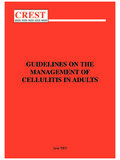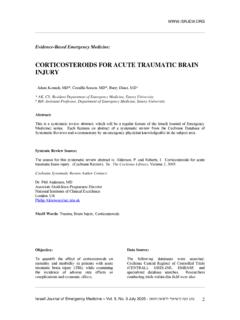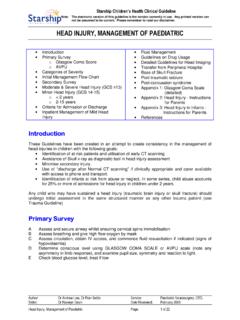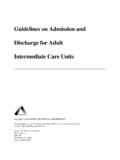Transcription of Traumatic brain injury - acutemed.co.uk
1 For personal use only. Not to be reproduced without permission of The LANCET Vol 356 September 9, 2000923 Traumatic brain injury is the most common cause ofdeath and disability in young people. There is much hopefor improvement in early care and functional outcome byuse of scientific evidence-based guidelines. Traumaticbrain injury is graded as mild, moderate, or severe on thebasis of the level of consciousness or Glasgow coma scale(GCS) score after resuscitation (panel). Mild traumaticbrain injury (GCS 13 15) is in most cases a concussionand there is full neurological recovery, although many ofthese patients have short-term memory and moderate Traumatic brain injury (GCS9 13) the patient is lethargic or stuporous, and in severeinjury (GCS 3 8) the patient is comatose, unable to openhis or her eyes or follow with severe Traumatic brain injury (comatose)have a significant risk of hypotension, hypoxaemia, andbrain swelling.
2 If these sequelae are not prevented ortreated properly, they can exacerbate brain damage andincrease the risk of death. Major improvements inoutcome can be achieved for such patients before theyreach hospital by rapid resuscitation and direct transportto a major trauma facility, and in the hospital setting bymonitoring of intracranial pressure and institution ofadequate cerebral perfusion. Two scientific, evidence-based documents2,3support this position and aresummarised in this the USA, for example, each year about 1 6 millionpeople sustain Traumatic brain injuries, of whom 800 000receive early outpatient care and 270 000 require year about 52 000 deaths and 80 000permanent severe neurological disabilities result fromsevere Traumatic brain financial burden isenormous.
3 Worldwide, injury is the cause of the largestnumber of disability-adjusted life years lost, whichincludes years lost to death and to varying degrees both more and less developed countries,motor vehicles are the major cause of deaths anddisabilities, particularly in young are theleading cause of death and disability from Traumatic braininjury in people older than 65 :356:923 29 brain Trauma Foundation and Weill Medical College of CornellUniversity, New York, NY 100221, USA(J Ghajar MD)Secondary injuryNeurological damage does not all occur immediately atthe moment of impact (primary injury ) but evolvesafterwards (secondary injury ). Secondary brain injury isthe leading cause of inhospital deaths after traumaticbrain secondary brain injury is caused bybrain swelling, with an increase in intracranial pressureand a subsequent decrease in cerebral perfusion leading hours of Traumatic brain injury ,vasogenic fluid accumulating in brain causes cerebraloedema, raises intracranial pressure, and lowers thethreshold of systemic blood pressure for reduction in cerebral blood flow oroxygenation below a threshold value or increasedintracranial pressure leading to cerebral herniationincreases brain damage and morbidity.
4 Severalpharmacological agents, such as free-radical scavengers,antagonists of N-methyl-D-aspartate, and calcium-channel blockers, have been investigated in an attempt toprevent the secondary injury associated with traumaticbrain injury , but none has proven and hypotension occur commonly beforethe patient reaches hospital and significantly increase therisk of secondary brain injury and the likelihood of a ,12In a study of children with Traumatic braininjury, 13% had a documented hypoxaemic episode and6% had hypercapnia. Various studies have reported that27% to 55% of patients with Traumatic brain injury werehypoxaemic (arterial oxygen saturation <90%) at thescene, in the ambulance, or on arrival at the emergencydepartment.
5 Intubation at the scene of the accident or inthe emergency department was required for all patients ifthe GCS score was 3 5, 73% if the GCS was 6 7, and62% if the GCS was 8 adults, hypotension is defined as a single measure- Traumatic brain injuryJamshid GhajarSeminarGlasgow coma scaleEye opening Motor response Verbal responseSpontaneous 4 Obeys6 Oriente d5To speech 3 Localises5 Confuse d4To pain2 Withdraws4 Inappropriate3 None1 Abnormal flexion 3 Incomprehensible 2 Extensor response 2 None1 None1 The decrease in mortality and improved outcome for patients with severe Traumatic brain injury over the past 25 yearscan be attributed to the approach of squeezing oxygenated blood through a swollen brain .
6 Quantification of cerebralperfusion by monitoring of intracranial pressure and treatment of cerebral hypoperfusion decrease secondary the patient reaches hospital, an organised trauma system that allows rapid resuscitation and transport directlyto an experienced trauma centre significantly lowers mortality and morbidity. Only the education of medical personneland the institution of trauma hospital systems can achieve further improvements in outcome for patients withtraumatic brain personal use only. Not to be reproduced without permission of The of a systolic blood pressure below 90 mm Hg. In twoUS studies, hypotensive episodes were observed in 16%11and 32%14of patients with severe Traumatic brain injuryat the time of hospital arrival and during surgicalprocedures, respectively.
7 A single episode of hypotensionwas associated with increased morbidity and doubling ofmortality. An Australian study reported similar children, a low systolic blood pressure, sustained for atleast 5 min, is associated with a poor outcome (table). Prehospital guidelinesEarly identification of severe Traumatic brain injury at anaccident scene, with proper assessment, treatment, andtransport destinations can lower the risk of secondaryinjury and subsequent long-term care costs. TheGuidelines for the Prehospital Management of TraumaticBrain Injury3address the assessment, treatment, andtransport decisions based on current scientific evidence(figure 1).Oxygenation and blood-pressure treatmentEndotracheal intubation decreases the risk of death forpatients with isolated severe Traumatic brain injury from50% to 23% and that for all trauma patients from 36% to26%.
8 15 Prehospital neuromuscular blockade forendotracheal intubation has also been successful, withstudies demonstrating the safety of short-actingneuromuscular blockade used at the scene of the accidentto facilitate endotracheal intubation by paramedics. In theabsence of signs of cerebral herniation, ventilatoryassistance after endotracheal intubation should beprovided (respiratory rate about 10 breaths per min foradults, 20 breaths per min for children, and 25 breaths permin for infants) until arterial blood-gas analysis isavailable to guide the minute ventilation (systolic blood pressure <90 mm Hg) should beprevented, rapidly diagnosed, and ,16,17 Theunderlying cause of hypotension in trauma patients ismost commonly haemorrhage; therefore, intravascularfluid is intuitively the most effective way to restore bloodpressure.
9 Adult resuscitation protocols involve the rapidinfusion of 2 L Ringer s lactate or normal saline as aninitial crystalloid , there is evidence thatearly restoration of blood pressure may worsen outcomein penetrating thoracic have also shownboth higher systolic blood pressure and better survival intrauma patients resuscitated with hypertonic salineinstead of crystalloid. Meta-analysis found that patientswho received hypertonic saline and dextran were abouttwice as likely to survive as those who received , hypertonic saline may decreaseintracranial pressure in patients with intracranialSEMINAR924 THE LANCET Vol 356 September 9, 2000 Age (years)Systolic blood pressure(mm Hg)<1651 5 70 755 1275 8012 1580 90 Systolic blood pressure associated with a poor outcome inchildren with Traumatic brain injuryScoreGCSEyesTreatmentTransportFirst priorityAirwayBreathingCirculationKeepSBP >90 mm HgSaO2 >90%(adults) severe Traumatic brain injury (comatose)
10 Intubate */hyperventilateEyes do not open to painIncomprehensible sounds or noneIntubate */normoventilateTransport toTrauma centre with TBI resources(GSC <9) +Ventilate and oxygenate if intubation not availableTrauma centre with 24 h scanning capability, 24 h available operatingroom, prompt neurosurgical care and the ability to monitor intracranial pressureand treat intracranial hypertension as delineated in the Guidelines for theManagement of severe Head injury ( )*+ScoreGCSV erbalScoreGCSM otorAssesspupilsLocalisation, withdrawalor flexor responseExtensor orflaccid responsePupils equalreactivePupils asymmetricor fixed and dilatedTransport toEmergency room (GCS 14, 15)Trauma centre (GCS 9 13)Says at least wordsEyes open, open to voice or open to pain Any motor responseAny pupil examOxygenateMild or moderate Traumatic brain injuryFigure 1: Prehospital triage for patients with Traumatic brain injurySBP=systolic blood pressure; SaO2=oxygen saturation; TBI= Traumatic brain injury .











